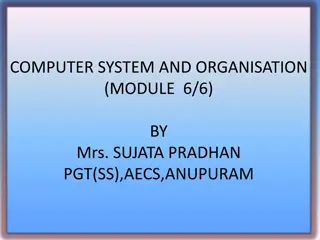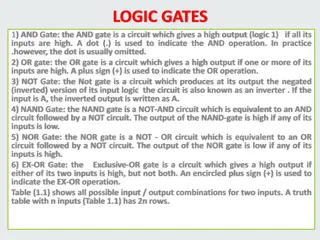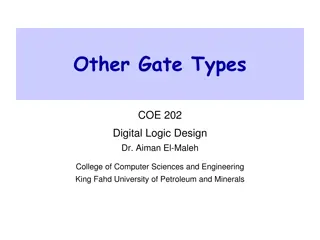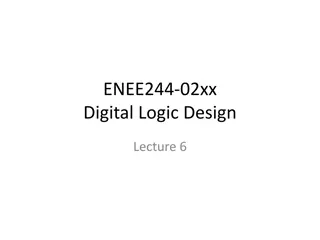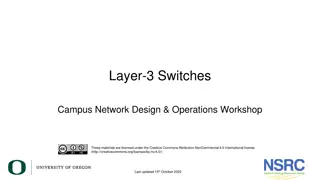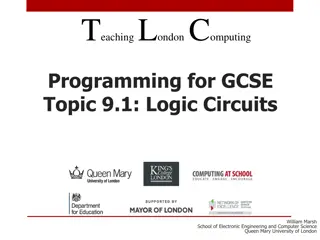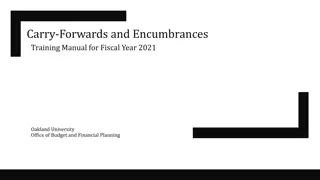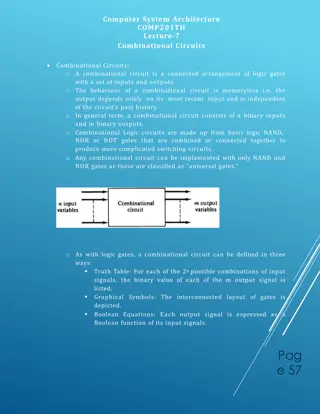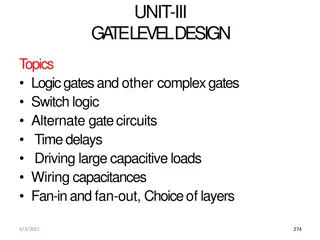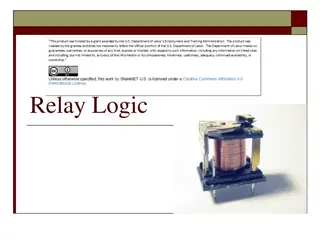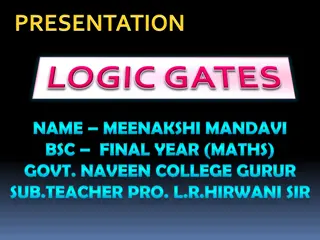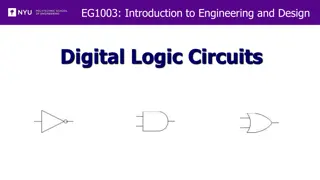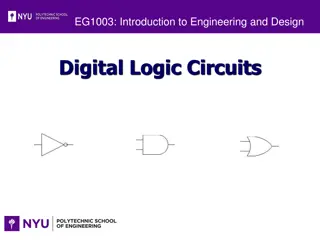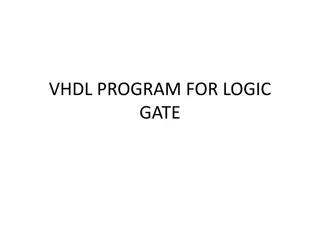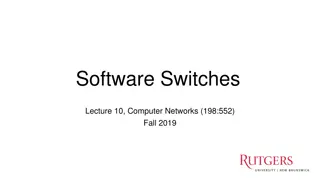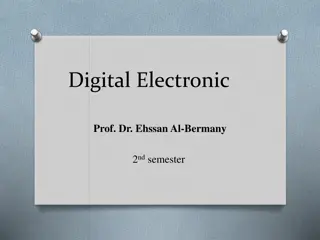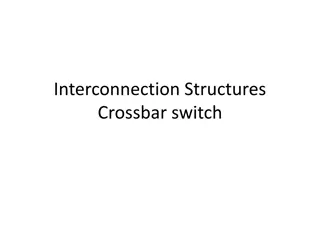Understanding Controllable Switches and Basic Logic Gates
Explore the concept of controllable switches and basic logic gates in the context of building machines that can perform complex tasks swiftly, such as weather forecasting, medicinal drug design, speech recognition, robotics, and artificial intelligence. Learn how controllable switches can be leveraged to create circuits that can automate decision-making processes through logical operations like AND, OR, and NOT gates.
Download Presentation

Please find below an Image/Link to download the presentation.
The content on the website is provided AS IS for your information and personal use only. It may not be sold, licensed, or shared on other websites without obtaining consent from the author. Download presentation by click this link. If you encounter any issues during the download, it is possible that the publisher has removed the file from their server.
E N D
Presentation Transcript
Controllable Switches modified from CS231 slides University of Illinois Howard Huang
Controllable Switches How can we make a Machine that can do complex things Add and multiply really fast Weather forecast, design of medicinal drugs Speech recognition, Robotics, Artificial Intelligence... Web browsers, internet communication protocols Starting at (almost) the lowest level 1 Introduction to CS231
The Modest Switch All these capabilities are built from an extremely simple component: A controllable switch The usual Electrical switch we use every day The electric switch we use turns current on and off But we need to turn it on and off by hand The result of turning the switch on? The top end in the figure becomes raised to a high voltage Which makes the current flow through the bulb The Controllable Switch No hands Voltage controls if the switch is on or off High voltage at input: switch on Otherwise it is off 2 Introduction to CS231
Using the switch Input Output is high (voltage) if and only if the input is high Output Now we can make one circuit control another switch Neat! This is getting boring.. 3 Introduction to CS231
Lets use them creatively Output is high if both the inputs input1 AND input2 are high If either of the inputs is low, the output is low. Input1 Output This is called an AND gate Input2 Now, can you make an OR gate with switches? 4 Introduction to CS231
OR Gate Input1 Output Input2 Output is low iff both inputs are low i.e. Output is high if either of the inputs (or both) are high (input1 OR input2) 5 Introduction to CS231
Basic Gates There are three basic kinds of logic gates NOT (complement) of one input AND of two inputs OR of two inputs Operation: Logic gate: A little circle on the output side means not x' means not x Two Questions: How can we implement controllable switches? What can we build with Gates? And How? 6 Introduction to CS231
Logic gates 1. AND gate (c = a . b) a 0 0 1 1 b 0 1 0 1 c = a . b 0 0 0 1 a c b 2. OR gate (c = a + b) a 0 0 1 1 b 0 1 0 1 c = a + b 0 1 1 1 a c b 3. Inverter (c = a) a c = a a c 0 1 1 0 4. Multiplexor (if d = = 0, c = a; else c = b) d d c 0 1 a b a 0 c b 1
How to make controllable switches? Use mechanical power Use hydraulic pressure Use electromechanical switches (electromagnet turns the switch on) Current technology: Semiconductor transistors A transistor can be made to conduct electricity depending on the input on the 3rd input CMOS gates (actually, switches) We can now manufacture 60 billion transistors on a single silicon chip! So, switches and Gates are not magic. We believe they can be built 8 Introduction to CS231
9 Introduction to CS231
Electromechanical Switches Closing the switch causes current to flow through the coil. Current in the coil creates a magnetic field. Magnetic field attracts the iron armature. Armature moves, bringing the contacts together. Power circuit is now on . The device is a controllable switch. 10 Introduction to CS231
Vacuum Tube Switches Electrons flow (thru a vacuum) from heated cathode (k) to anode (a). Anode is at high positive voltage (+100 volts or more) and attracts electrons. A negative voltage on the grid (g) repels the electrons and stops the flow. A positive voltage on the grid attracts the electrons and lets electrons flow. Voltage on the grid controls the current (k) to (a). The device is a controllable switch. 11 Introduction to CS231
Transistor Switches A small change in the voltage applied across the base (B) emitter (E) circuit greatly changes the current in the collector (C) emitter circuit. The device is a controllable switch. 12 Introduction to CS231
Brain Switches (Neurons) Several other neurons connect to the dendrites of a neuron at its synapses. If enough of them electrically stimulate the neuron, it fires, and sends an electrical signal down its axon. Its axon is connected to other neurons. The device is a controllable switch (in this very simplified view.) 13 Introduction to CS231
A little bit about technology Two properties of Switches and Gates: Size Switching and propagation delay Smaller the size, smaller the propagation delay (typically)! Smaller the size, cheaper the processor! Silicon is sand anyway But you can put more logic on a single chip This nice positive feedback cycle has Made processors faster and cheaper Over the last 70 years! 1941: Z3, 2000 electro-mechanical relays 1946: ENIAC, 1800 vacuum tubes Regarded as the first fully programmable electronic computer 1972: Intel 4004, 2300 transistors 2013: 8-Core Itanium , 3 billion transistors Before 1972: Processors were built with MANY chips, or individual transistors 14 Introduction to CS231
Summary Controllable Switches are easy to make These switches can be used to put together Logic Gates Logic Gates can be put together to make bigger circuits These circuits can be put together to make even bigger circuits. Logic Gates can be used to make circuits that remember or store data A Computer includes, at its heart : An ALU (Arithmetic Logic Unit) Instruction Decoding and associated circuits Memory Stored Program 15 Introduction to CS231
License Attribution-NonCommercial-ShareAlike 1.0 You are free: to copy, distribute, display, and perform the work to make derivative works Under the following conditions: Attribution. You must give the original author credit. Noncommercial. You may not use this work for commercial purposes. Share Alike. If you alter, transform, or build upon this work, you may distribute the resulting work only under a license identical to this one. For any reuse or distribution, you must make clear to others the license terms of this work. Any of these conditions can be waived if you get permission from the author. Your fair use and other rights are in no way affected by the above. 16 Introduction to CS231




